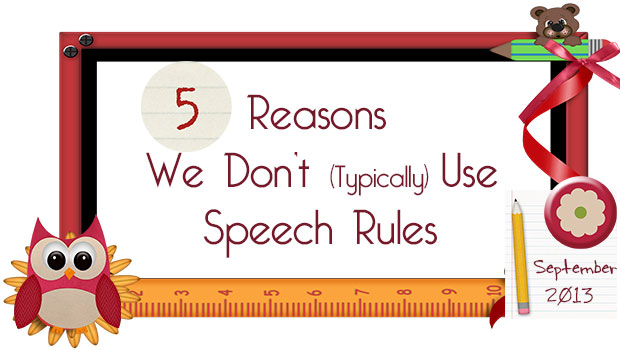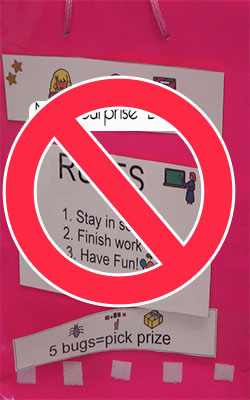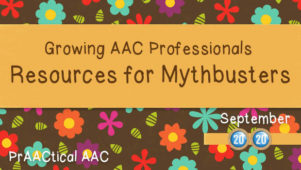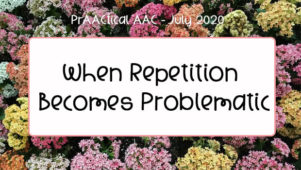5 Reasons We Don’t Usually Use ‘Speech Rules’

 We love organized productive speech therapy sessions. But, we don’t typically use speech rules in our sessions. It’s not that we are inherently against ‘behavior speech rules’ but overall, we don’t use them. Here are some of the reasons why:
We love organized productive speech therapy sessions. But, we don’t typically use speech rules in our sessions. It’s not that we are inherently against ‘behavior speech rules’ but overall, we don’t use them. Here are some of the reasons why:
- We use meaningful language activities. We try to use meaningful, fun, and engaging activities so learners want to participate. Even when we think an activity is enjoyable and it is not, it becomes enjoyable and meaningful to “stop” the activity. It is helpful to think about meaningful and fun from the learner’s perspective and not just ours. For example, having a pleasant conversation about awesome pretty pictures would be enjoyable for many students. However, if conversation is difficult, maybe not so much. It’s not that we would not work on conversation, but the activity structure may involve clear beginnings and endings to the conversation, a ‘take home poster’, and/or a talk time snack, not just the conversation.
- We use visual supports. Visual supports show boundaries and expectations so the students know the expectations of the session. The expected behavior comes from the support not from a power struggle between ‘my’ rules and the students.
- We are not good at NOT giving prizes. Usually with ‘speech rules’ there is a prize at the end of the session based on behavior. Since, our goals focus on communication and language, it seems counterproductive to give reinforcement based on behavior. It is very hard to look at a student after a session and not give them the prize. We often see SLP’s giving the child many chances to ‘earn’ the prize back (which is great but what does that teach?). Only on the rarest occasion have we seen a student not leave with the prize. When this happens, the session usually ends with tears or worse, no care which means the ‘prize’ is meaningless to goals and objectives (learning). There are a group of students who do LOVE prizes and that is awesome, it just seems that there is a more meaningful language activity to getting a prize than a set of behavior rules (e.g., requesting, negotiating, playing store, etc.).
- We Give Choices– With the power of choice, students often will participate more readily and appropriately. Sometimes, the choice may be a different activity, or different materials, or even not liking any of the choices but choices change the dynamics of behavior immediately.
- Our focus is communication. The purpose of a speech-language intervention session is to improve communication and language skills, not to improve behavior. We serve as communication partners, not ‘bosses’. We are aiming for improved communication not perfect compliance. When we see ‘speech rules’ the focus often is about compliance. Another aspect of a communication focus is authenticity. We like to model appropriate pragmatics or social use of language. In typical social communication and conversation, there is not an arbitrary rule about sitting, or having feet on the floor etc. Therefore, by adding ‘behavior speech rules’ we are distorting the social rules of communication and this often does not help our students accomplish their goals and is not authentic or real. Additionally, if communication is not enjoyable and sustainable on its own and because of the interaction, it will not be maintained outside the ‘speech room’ and that would not help anyone.
What are your thoughts on behavior speech rules?
Filed under: PrAACtical Thinking
Tagged With: boundaries, meaninful language experiences, rules, visual supports
This post was written by Robin Parker





7 Comments
I love, love, love this post!!
Thanks so much for reading and taking the time to let us know your thoughts.
I so totally agree with this post! There is a treasure box at my office and the one time I tried using it by withholding I realized we all felt awful and achieved nothing. Basically for me “you show up, you get a prize on the way out.” The one speech rule I do have is for myself: Make the session so rich with fun, engaged communication and connectedness that the child does not want to leave when the hour is up.
Thanks so much for taking the time to write. Love your rule for yourself!
I agree in general with much of this article. I do enforce rules with middle and high schoolers I see at a school for kids with emotional/behavioral issues. The primary rule is
to show respect for ourselves and others, which also translates into no foul language, no inappropriate body sounds or touching, etc. The students know that they are expected to behave well in our sessions and for the very most part they do. I do not tie their compliance to any prize, it is just an expectation that is laid out and reinforced with them in our initial sessions.
For the younger kids I have sometimes had to set limits on certain behaviors that have intruded, particularly with the kids I see on the autism spectrum. For instance, I have used visuals stating “No nose picking” or “No sniffing Miss Judy”. These visual reminders have worked very well and often after a couple of sessions the problem behavior is eliminated. I think we do kids no favors to allow hem to persist in behaviors which are potentially upsetting to others. Part of social/pragmatics is learning to respect boundaries and keep private behavior private. So on that note I partially disagree that we are not concerned with “behavior” .
We certainly agree with limit setting for ALL ages. We have many limits and boundaries within our sessions and in our classrooms. We just try make them contextually relevant with some alternatives “no picking nose , use a tissue”. About something like sniffing, we might teach student to ask Can I sniff you? or Can I smell your perfume? rather than just saying no sniffing because then we could capitalize on a communication goal. Also, then the person (any person- not just Miss ____) can say yes, or no. Some people do not mind this if asked first. So the rule might be: first ask to sniff, then listen for the answer. We would prAACtice giving both yes and no answers to the request until the learner understood, then we would begin giving true answers. We might even write a social narrative if we (as the speech teacher) really did not like a person sniffing us (if it was our personal pet peeve). Once again, I think we agree more than disagree, but framing the rules and boundaries as communication opportunities (both receptive and expressive) has been more effective than setting up an arbitrary set of rules that many learners can not follow without communication opportunities, visual supports and AAC displays.
Good points and I agree totally with your suggestions!